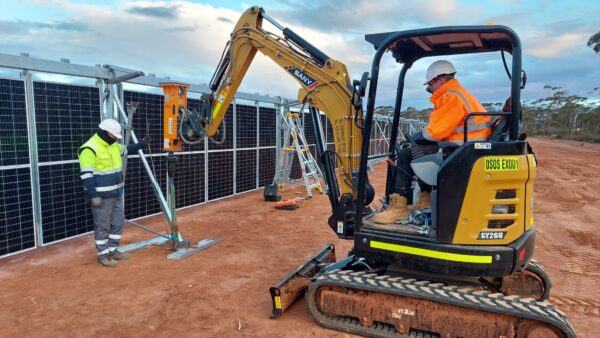Cambridge Energy said the first Australian deployment of its Nomad system – that combines solar tracking technology in a prefabricated and modular design – has now been completed at Norton Gold Fields’ Binduli mining operation near Kalgoorlie in Western Australia’s Eastern Goldfields region.
“We were thrilled to have hosted site visits last week showcasing our newly completed Norton Binduli 2.3 MW Nomad project,” the company said.
“The success of this deployment was a proud achievement for us, and for the renewable energy landscape, demonstrating the huge potential for ultra-low cost solar here in Australia.”
“We now have firm proof of how the Nomad outperforms other technologies in the region and that prefabricated solar tracking will enable the next big leap.”

Cambridge, which delivered the project for Perth-based energy and mining consultancy ResourcesWA and investment firm CrossBoundary, said its Nomad system is the only PV solution in the world that combines prefabrication with solar tracking, setting “a new standard in delivering efficient, cost-effective, and sustainable solar.”
“The technology revolutionizes solar energy by offering the benefits of solar tracking in a unique, prefabricated design,” the company said. “It maximizes energy yield, making solar projects more feasible, cost-effective, and socially responsible.”
Cambridge which was founded by Australian Tom Miller, said the Nomad system features bifacial panels mounted on a single-axis tracking system which allows for maximum energy output, claiming the Nomad generates 45-50% greater yield than other prefabricated solutions.
The system also features an innovative anchoring solution that eliminates the need for piles and concrete. The tracker is anchored to the ground using percussion-driven earth anchors that utilize the soil as a counterweight and are connected to the structure through cables.
“This anchoring method eliminates the need for extensive groundworks, steel piles or concrete, and ensures minimal disruption to the soil during installation and decommissioning,” Cambridge said.

The system has been designed to be stored in a shipping container, and Cambridge said it can be removed and reinstalled as and when required with the modular design reducing inefficiencies in transport and installation, while making for faster deployment than conventional solar, resulting in lower deployment costs.
Trent Colyer, managing director of Perth-based OSOS Global Services which provided the installation team behind the 2.3 MW Binduli project, said the install had gone much quicker than expected.
“We had never installed one of these Cambridge models before, and no one in Australia has either. But they’ve made it very, very simple for us to do it,” he said.
Colyer said the small installation crew had deployed 1 MW per week using regular construction machinery.
This content is protected by copyright and may not be reused. If you want to cooperate with us and would like to reuse some of our content, please contact: editors@pv-magazine.com.




By submitting this form you agree to pv magazine using your data for the purposes of publishing your comment.
Your personal data will only be disclosed or otherwise transmitted to third parties for the purposes of spam filtering or if this is necessary for technical maintenance of the website. Any other transfer to third parties will not take place unless this is justified on the basis of applicable data protection regulations or if pv magazine is legally obliged to do so.
You may revoke this consent at any time with effect for the future, in which case your personal data will be deleted immediately. Otherwise, your data will be deleted if pv magazine has processed your request or the purpose of data storage is fulfilled.
Further information on data privacy can be found in our Data Protection Policy.